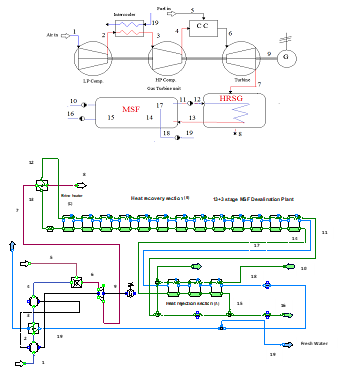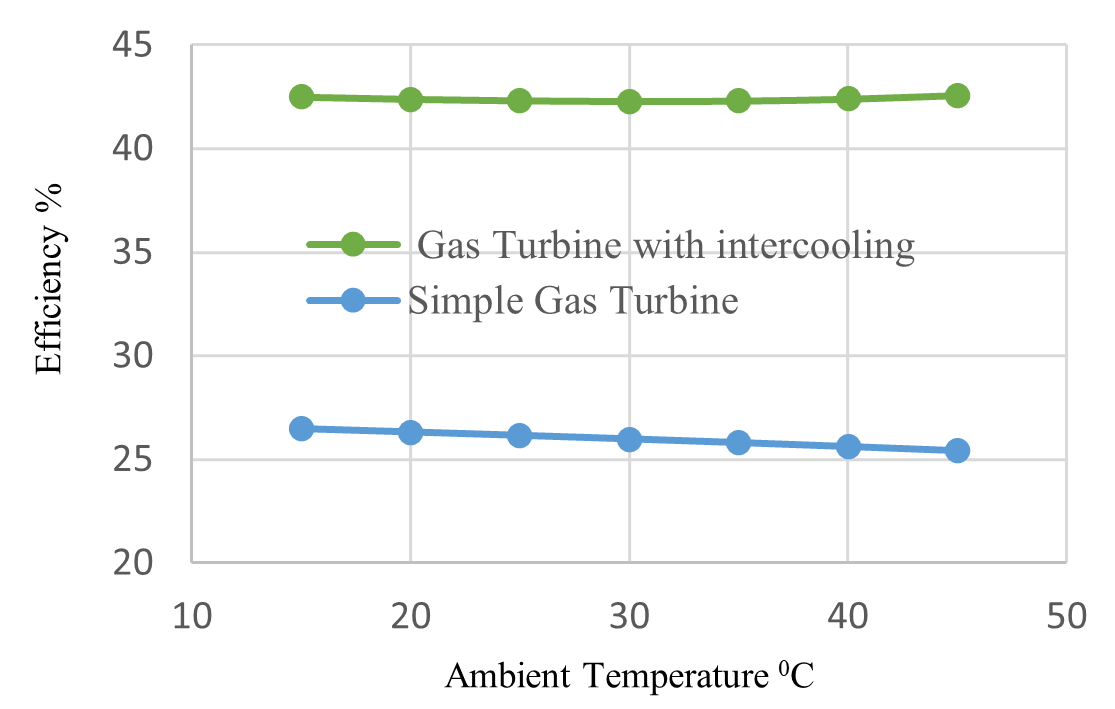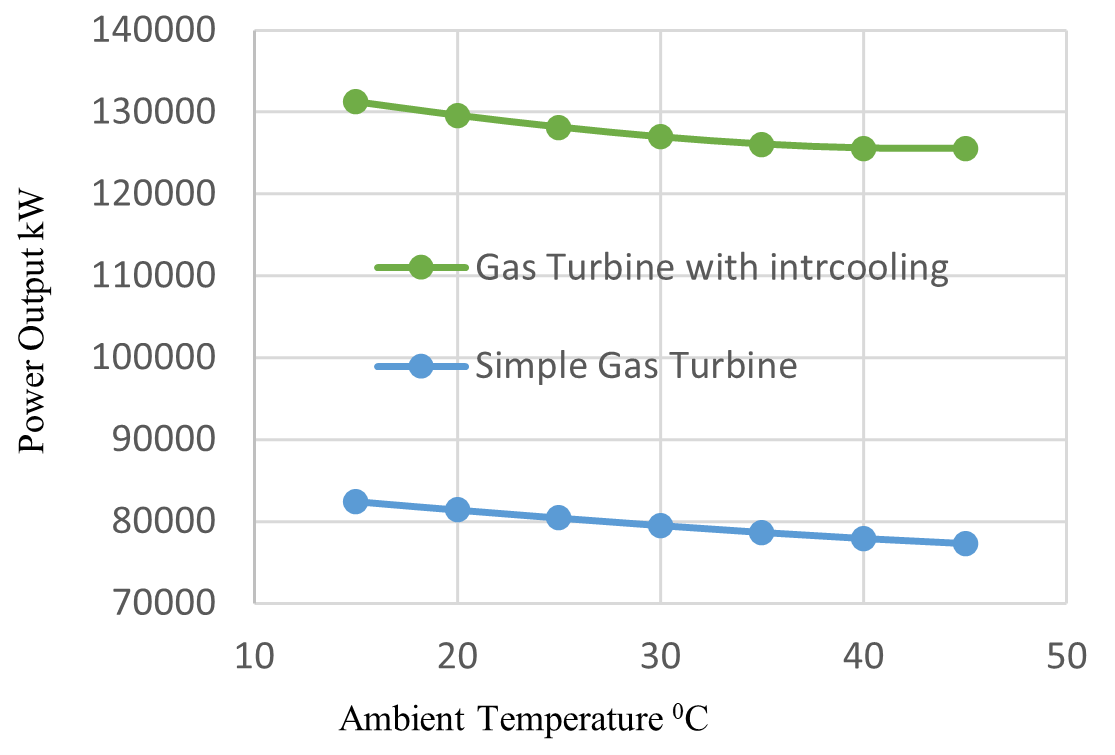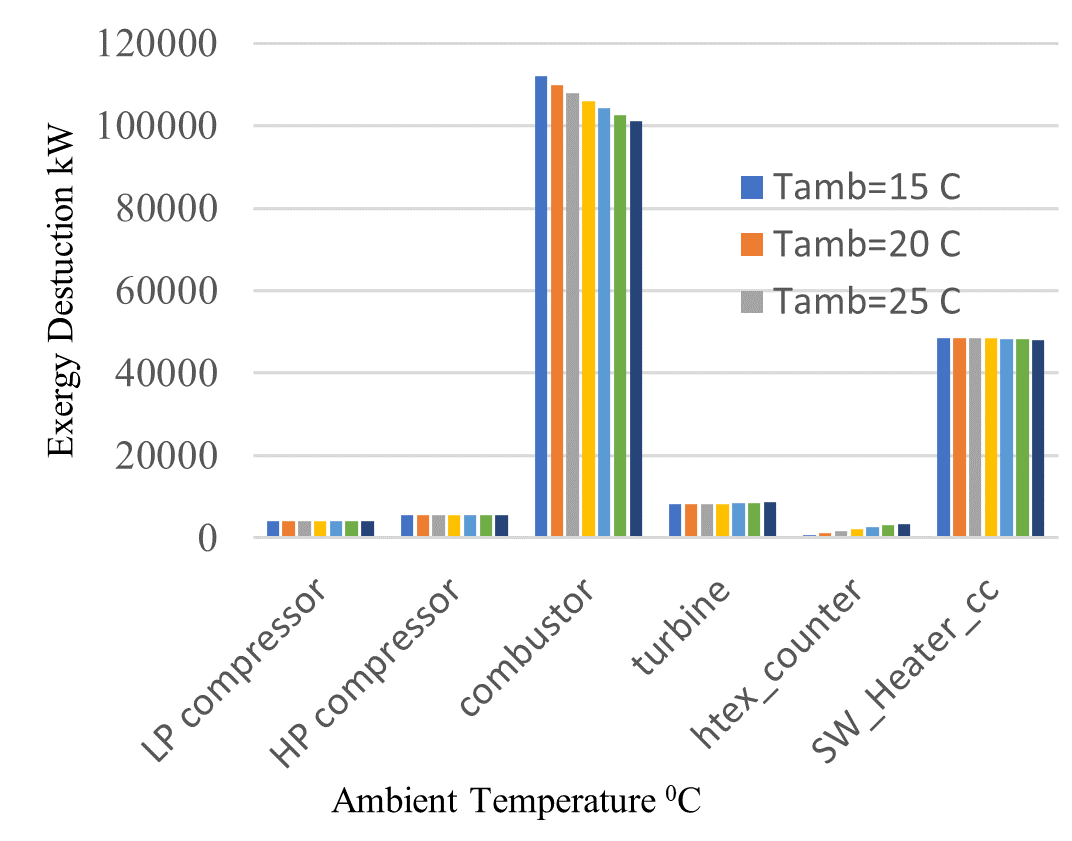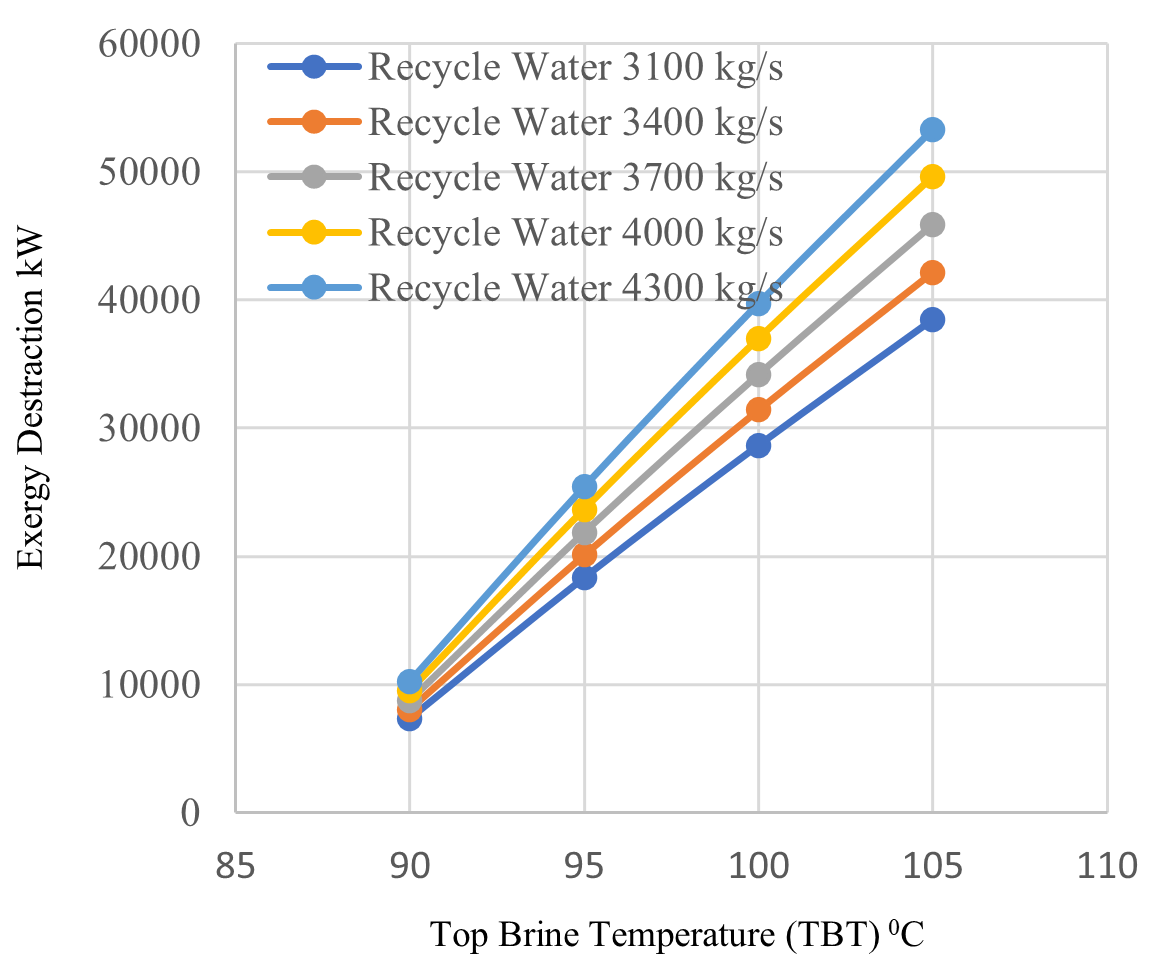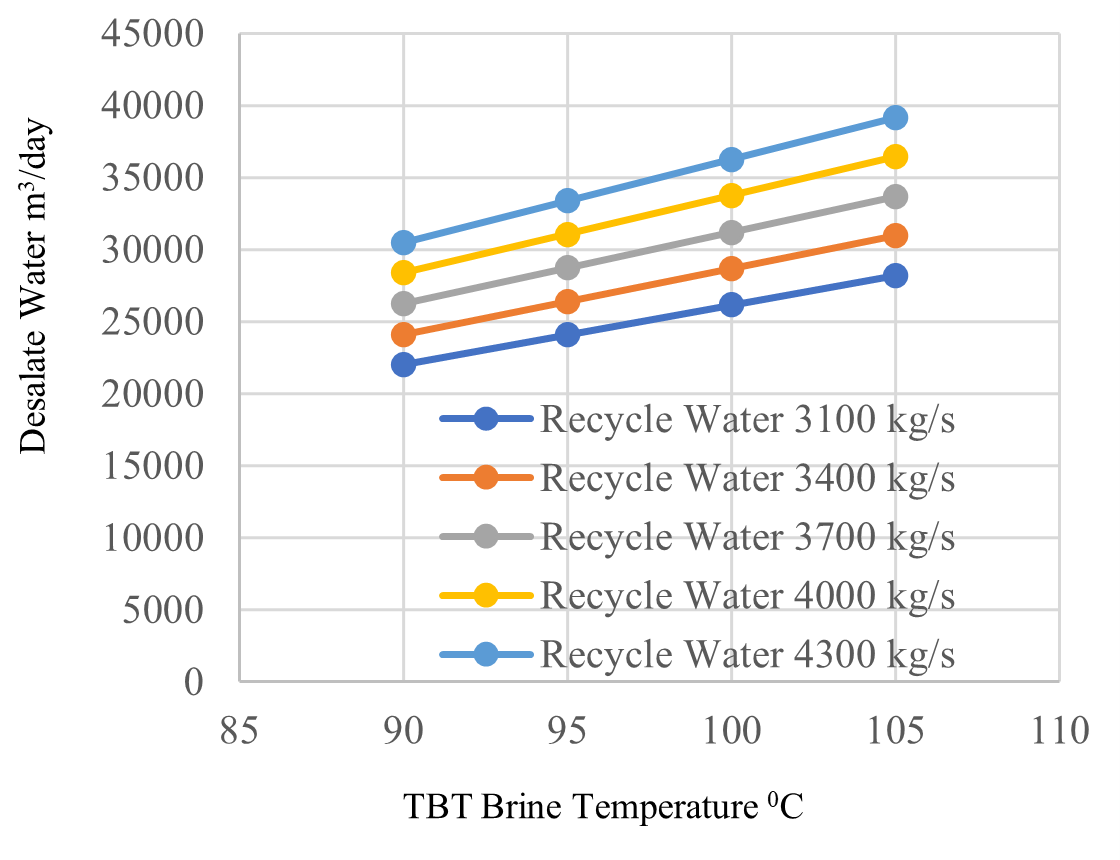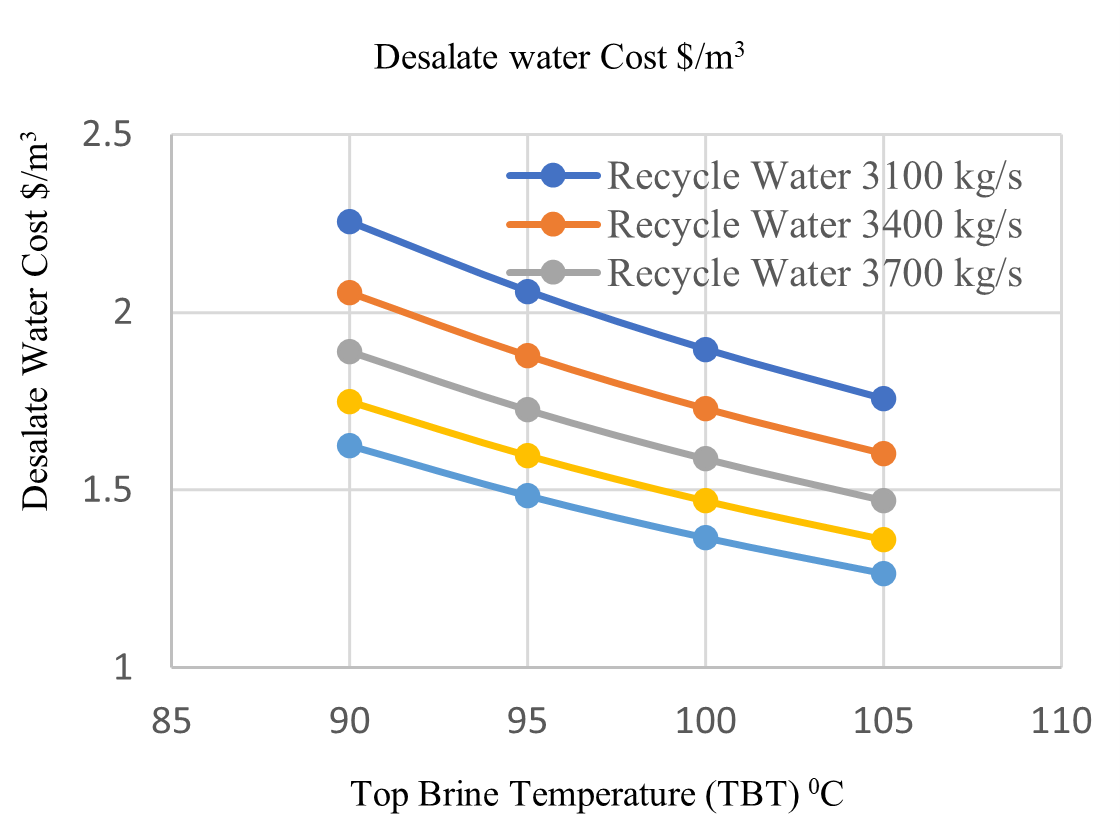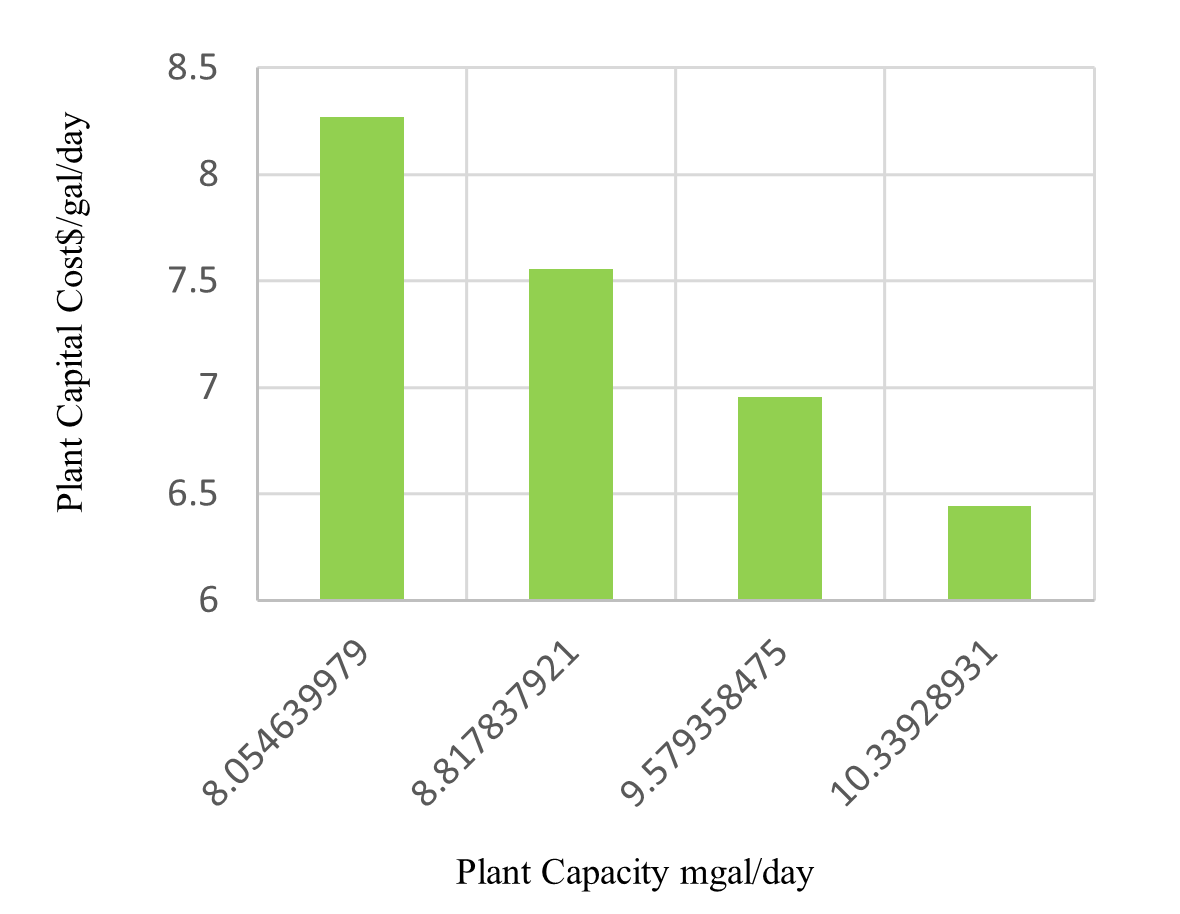Thermo-Economic Analysis of Gas Turbine Combined Multistage Flash (MSF) Desalination Cycle
- Dr. Entesar. H. Betelmal Rau
- Eng. Abdurrauf. M. Naas
- 445-455
- Jan 12, 2024
- Engineering
Thermo-Economic Analysis of Gas Turbine Combined Multistage Flash (MSF) Desalination Cycle
Dr. Entesar. H. Betelmal Rau, Eng. Abdurrauf. M. Naas
Department of Mechanical Engineering Tripoli University, Faculty of Engineering Tripoli-Libya
DOI: https://doi.org/10.51244/IJRSI.2023.1012033
Received: 01 December 2023; Revised: 10 December 2023; Accepted: 14 December 2023; Published: 11 January 2024
ABSTRACT
Over the past few decades, the growth of the earth’s population has increasingly contributed to global warming, and increased demand for fresh water on top of a need for a greater power supply. This paper will analyze the integration of a combined- gas turbine with intercooler and a multi-stage flash (MSF) desalination plant for the simultaneous generation of electricity and supply of water and improved performance. The paper will also examine the calculation of the production cost and the capital cost of the MSF desalination plant. The thermo-economic analysis of the study was conducted using the IPSEpro software system. Also, exergy losses of the gas turbine and MSF desalination unit were also calculated. The desalination plant uses the exhaust gases from the gas turbine, as a form of thermal energy, and discharges to feed the seawater heater. A portion of the desalinated water is used to cool the compressed air in the intercooler heat exchanger. Results indicate the improvement in the gas turbine’s performance when desalinated water is used for the intercooler between compressor stages, as the power output increased by 59% over the the simple gas cycle and found decrease with an increase in the ambient temperature. The desalinated water cost was calculated to be $1.7 per cubic meter after determining the optimal configuration and operating conditions. A decrease in steam cost by 36% was observed when the waste heat from the gas turbine was used as the source of thermal energy. Part of this reduction can be explained by the observation that the desalination plant’s pumps consume part of the power generated by the gas turbine.
Keywords: multi-stage flash (MSF), gas turbine, combined cycle, cost, energy, and exergy analyses
Nomenclature
Symbol
Cp specific heat (kJ/kg. K)
f load factor
GOR Gain Output Ratio
h Enthalpy (kJ/kg)
I Irreversibility (kW)
m mass flow rate (kg/s)
n number of years of the investment time frame
Qin inlet heat (kW)
s Entropy (kJ/kg .K)
φ exergy (kW)
TBT Top Brine Temperature (0C)
T0 Atmospheric temperature (298 K)
Subscripts
a air
ex exit
in inlet
f fuel
g gas
gen generation
INTRODUCTION
Seawater desalination is a process that consumes energy intensively [1]. Over the time a conventional desalination would not be sustainable. The shortage of fresh water coupled with the increase in its consumption due to global economic and social development has led to the development of desalination plants and call for the integration of these into power plants. Compared to a conventional plant, gas turbine combined MSF desalination cycle reliable and efficient.
Recently. The MSF desalination plant has a series of stages and three distinct sections as shown in figure 1: heat rejection section (A), heat recovery section (B) and brine heater (C). The feed water at ambient temperature warms up as it passes through the stages. On leaving the first rejection stage the feed stream is split into two parts, seawater rejection which passes back to the sea and a makeup stream which is then combined with the recycle stream. The combined stream now passes through a series of heat exchangers when it reaches the seawater heater where additional heat is added. The brine then enters the first heat recovery stage. As the brine was already at its saturation temperature for a higher pressure, it will become superheated and flashes to give off water vapor. The vapor is condensed and drips into a distillate tray. The process is then repeated all the way down the plant as both brine and distillate enter the next stage. The gas turbine cycle using the intercooler heat exchanger combined with the MSF desalination cycle is examined in this study. In this design we can reduce the cost of thermal energy needed for desalination plants by using the exhaust gases from the gas turbine to heat the seawater and thus reduce the exhaust gas temperature and pumps of the desalination plant consumes part of the power generated by the gas turbine [2]. IPSEpro software system for simulating a process was used to perform a thermo-economic analysis of this study.
LITERATURE REVIEW
The literature reviewed shows that energy, exergy, and thermo-economic analyses are fundamental for enhancing energy, exergy, and economic performance of power-desalination cycle.
Osman A. Hamed [3] evaluated the performance of a combined gas/steam power generation cycle integrated with a hybrid multistage flash (MSF)/seawater reverse osmosis (SWRO) desalination plant using a thermo-economic study based on exergy analysis. The results showed that the heat rate of the combined gas/steam power cycle is 6,388.94 kJ/kWh, corresponding to an overall thermal efficiency of 56.34%. On the other hand, the water-specific fuel consumption of the hybrid SWRO/MSF plant is 33.74 kWh/m3.
An economic model of the system is presented according to the total Revenue Requirement (TRR) method by Seyed Reza Hosseini, et [4]. The results showed the power and water costs increased 4.1% and 6.4%, respectively. the relationship between the production cost and the system availability has been studied using sensitivity analysis which can help the designer to decide how to improve the profit or competitiveness.
The combined water and power plant (CWPP) combination of membrane processes with multi-stage flash (MSF)/multi-effect distillation (MED) thermal processes have been used to harness the maximum wasted energy from a power plant. A thermoeconomic analysis under different loads has been used by Fazle Mahbub [5] to quantify the benefits of the CWPP. The study shows the CWPP thermal efficiency of around 63% compared to conventional 44%.
A thermoeconomic analysis of MSF desalination plant using a modular simulation code, CAMEL, developed by the University of Roma, has been studied by P. Fiorini and E. Sciubba [6]. The work calculates the exergy losses in each component. A thermoeconomic analysis of the combined cycle has been performed in order to determine the cost of steam and electricity. The results show that capital- and steam costs are equally important in determining the optimal operative conditions.
PLANT DESCRIPTION
Figure 1 shows the gas turbine cycle (i.e., compressor, intercooler heat exchanger, combustion chamber (cc), gas turbine) and MSF desalination cycle (i.e., heat recovery and heat generation). The intercooler is inserted between two stages of the compressor to lowering the temperature. This decreases the power requirement of the compressor. Therefore, the net power output of the cycle is improved. Multi-stage flash distillation (MSF) is most used in plants. The main reasons are its high reliability, its flexibility of operation and the relatively low influence of salt-induced fouling in the heat exchangers [6]. The system shown in figure 1 is a gas turbine with intercooler cycle combined with the MSF desalination plant. The system consists of a two-stage air compressor, intercooler heat exchanger, a combustion chamber, and a gas turbine as the upper part and 13+3 stage MSF desalination as the bottom part. The inlet air has a pressure of 1 bar. The isentropic efficiency of the turbine and compressor is 90 and 85 %, respectively. The pressure drop through the combustion chamber and intercooler heat exchanger is 1% of the inlet pressure. Methane (CH4) gas enters the combustion chamber at 20°C and 25 bars. In our cycle, the compressor pressure ratio is 14 and for each of the two compressor stages, pressure ratios are 3 and 4.8, respectively. Owing to the heat absorption in the intercooler, the temperature of the hot air discharged from the first stage decreases. The maximum temperature of the gas turbine cycle is 13000C. The exhausted gas from the turbine is fed to the brine heater of the MSF desalination plant to recycle the seawater. The MSF desalination plant mainly consists of two main sections, the heat recovery section, and the heat rejection section as shown in figure 1. The first one recovers (by condensation) the heat of the flashing brine; the number of stages depends on the environmental conditions and requested performance. The seawater is sent to the MSF plant and heated as it flows through the stages of the heat rejection section [1, 7]. The MSF desalination efficiency is defined as the ratio between the desalination production rate and the steam consumption (GOR, gain Output Ratio) [8].
Figure 1. Intercooling Gas Turbine Combined with MSF desalination Plant.
THERMO-ECONOMICS ANALYSIS
Exergy analysis usually predicts the thermodynamic performance of an energy system and the efficiency and identify the source, and the magnitude of the thermodynamics inefficiencies of the system components by quantifying the entropy generation of the components. This analysis provides a tool for the optimal design and operation of complex thermal systems. The exergy and irreversibility equations for each component are written as follows [9]:
Compressor
The exergy and irreversibility in compressor are given by
φc=ma*(hin-hex )-T0 ma (sin-sex ) (1)
Ic=T0 ma (Sin-Sex) (2)
Where
sin-sex=cpa ln〖Tex/Tin 〗-Ra ln〖Pex/Pin 〗 and Ra=Cpa ((γ-1))/γ (3)
Combustion Chamber
As an approximation, the virtual power is used to calculate the exergy of the combustor component. The exergy balance of this component and exergy loss due to irreversibility in the combustion chamber is given by.
φc.c=Qin+T0 Sgen (4)
Ic.c=T0 Sgen (5)
Where,

Turbines
The exergy loss due to irreversibility in gas turbine is given by.
φT=ma*(hin-hex )-T0 ma (sin-sex ) (7)
IT=T0 mg (Sex-Sin ) (8)
Where
(9)
Heat exchanger
The exergy loss due to irreversibility in heat exchanger is given by.
Where
(14)
MSF UNIT OVERALL EXERGY ANALYSIS
Exergy is defined as the maximum obtainable useful work when a system is moved to equilibrium from the initial state to the environmental (dead) state. [10, 11]
Total specific exergy stream consists of,
φtotal= φth + φch +φpo +φk.e (15)
The chemical exergy Ech potential exergy Epo, and kinetic energy Ek.e can be ignored, so the total exergy can be expressed as,
φ_total= φth= (h-h0 )-T0 (s-s0) (16)
Exergetic Destruction = φin – φout (17)
The overall efficiency of the cycle (ηc) is calculated using the following equation.
ηc =(power output)/(mf*heating value) (18)
Gained Output Ratio (GOR) is a measure of how much thermal energy is consumed in a desalination process, typically defined as the number of kilograms of distilled water produced per kilogram of steam consumed, i.e., Lower values are typical of applications where there is a high availability of low-value thermal energy.
GOR = (desalate flow rate)/(steam flow rate) (19)
DESALINATION COSTING METHODOLOGIES
In order to determine the capital and operating costs of the multi-stage flash MSF desalination plant, the cost of a specific reference design was used. The costs of the MSF plant in this study have been calculated based on the reference design and the assumptions are given in the cost aspects study [12]. For economic calculation, the factory life is 20 years, and the compound interest rate is 8% per year. The required plant capacity and the performance ratio will establish the basic cost of the process. Once this cost has been established for a particular performance ratio, the cost of differently sized plant capacities may be approximated from the following formula.
(20)
where
Ca is the cost of the known plant ($),
Cb is the cost of the new plant ($),
Sb is the capacity of new plant mgal/ day,
Sb is the capacity of known plant mgal/ day,
f is the plant capacity scaling factor,
Using the equation (20) to determine the capital cost of the plant with a production capacity of 6.2 mg/day when the cost of the reference plant design of 1.0 mg/day is $19,264,135.00, and the scale factor is 0.68. It must be mentioned that this formula is accurate for size changes of a factor of about 2. The greater the dimensional change, the lower the accuracy of the result.
Cb =19,264,135*(6.2/1)0.68 (21)
Cb = $ 66,615,587.43 (22)
The operating cost (Cop) and fixed cost (Cfix)of the reference design is $1,346,265 and $1,506,970, respectively. In this paper we can estimate the cost of the MSF desalination plant according to the following equation [9]. The scale factor of 0.80 has been used to estimate the operating cost. In contrast to capital costs, operating costs increase with the increase in plant capacity.
Cop = 1,346,265*(6.2/1)0.8 (23)
Cop = 5,794,872.792 $
Cfix = 1,506,970*(6.2/1)0.8 (24)
Cfix = 6,486,612.554 $
The capital and operating (O&M) costs are the major production costs of the MSF plant. By multiplying the annuity cost by the annuity coefficient, the following formula [25] can be used to determine the annual amortized capital cost (Ca).
(25)
Where:
i is a discount rate, n is the plant life and Ca is the annual amortized capital cost.
Ca = 5,807,850.477 $/yea
The annual capacity of the MSF plant is used to calculate an annual capital cost (Cu) and an annual operation and maintenance cost (CO&M) [4], as a result, the production cost (Cp, US $/m3) used to produce fresh water can be calculated as follows:
(26)
Total cost of desalinate water.
Cp = 1.749870213 $/m3
To determine the optimal working condition, two sensitivity analyses have been conducted: changing the TBT from 90 to 105 °C in 5-steps and changing the recycle mass flow rate from 3100 to 4400 kg/s in 300 kg/s-steps. In this study, a 13-stage factory was used to represent the case. The main operating parameters are TBT = 90°C, circulating mass flow rate = 3400 kg/s.
RESULTS AND DISCUSSION
Gas turbine is a major component of the gas turbine combined (MSF) desalination cycle. Figure 2 shows the efficiency of gas turbine with the intercooler for which the analysis was conducted. The intercooled system can improve the gas turbine efficiency 42.5% which is higher than that of the simple gas turbine which is equal to 26%.
Fig. 2 Efficiency as a Function of Ambient Temperature in Simple and Intercooling Gas Turbine
The power output decreases as ambient temperature increases as shown in figure 3. Figures 2 and 3 show a significant improve in the performance with the use of an intercooler between the compressor stages.
Fig. 3 Power Output as a function of Ambient Temperature in Simple and Intercooling Gas Turbine
One of the most important parameters of energy costs is the energy consumption, which is to be reduced in any way, using the exhaust gases that come out from the topping gas turbine cycle as the heat source to feed into the SW heater can be an effective way to achieve this, and we can extract part of gas turbine output to power water pumps.
Table (1) shows the electrical energy consumed by the pump and the steam sent to the brine heater.
Table (1) MSF plant cost parameters and results
| MSF Desalination Plant | 16 Stages |
| Recycle mass flow rate (kg/s) | 3400 |
| TBT (°C) | 95 |
| Production (kg/s) | 305 |
| GOR | 1 |
| Capital cost of the reference design ($) | 19,264,135.00 |
| Cost of the new plant ($) | 66,615,587.43 |
| Operating costs ($) | 5,794,872.792 |
| Fixed cost ($) | 6,486,612.554 |
| Electricity ($/hr) | 76.89852988 |
| Steam ($/hr) | 239.4719615 |
| Annual amortized capital cost ($/year) | 5,807,850.477 |
| Total cost of desalinate water ( | 1.7498 |
In the figure below we can see the exergy destruction of the components of the gas turbine cycle with the intercooling. It can be seen from Figure 4 that under full load conditions, the environmental temperature has an effect on the exergy destruction rate of the system components. As the ambient temperature increases from 15°C to 45°C, the irreversibility decreases in the system components. The largest exergy destruction occurs in the combustion chamber, followed by the SW heater, while the exergy destruction in the other components is not significant.
Fig. 4 Exergy Destruction in the Gas Turbine Components
In addition, by increasing Top Brine Temperature (TBT) and increasing circulating water, the irreversibility of the MSF desalination plant will also increase. This means that there are optimal parameters to design the plant according to the required productivity and operating conditions as shown in figure 5.
Fig. 5 Exergy Destruction in MSF Plant at Different Recycle Water
The desalinated water production has been influenced by the operation temperatures, where it is increased by increasing the temperature (TBT) and decreases by decreasing the recycle water flow rate.
Fig. 6 Desalinated Water Production per Day vs. TBT at different Recycle Mass Flow Rate
Figure 7 shows the cost rates ($/m3) for the base case configuration. Our results demonstrate that the cost of desalinated water is more sensitive to recycle water flow rate than to the TBT, the lower the recycle mass flow rate, the lower the distillate cost.
Fig. 7 Total Cost per m3 of Desalinate Water vs. TBT at different Recycle Mass Flow Rate
This result shows that as the factory’s capacity increases, the unit cost decreases, as shown in figure 8. This result is referred to as the “economy of scale”. The costs illustrated in figure 8 is for the cost of the process only, the costs for the auxiliary equipment, buildings, pre-treatment are not included, if these costs are added, the economy of scale will not be accurate.
Fig. 8 The Plant Capital Cost vs. Plant Capacity
CONCLUSION
Thermoeconomic analysis of gas turbine combined MSF desalination cycle is presented. From the results presented in this theoretical study of the gas turbine performance, exergy destruction, desalinated water production per day and total cost per cubic meter of desalinated water are determined based on the derived equations, we can conclude the following:
- The performance ratio (PR) of the plant has been significantly decreased by using exhausted gases as a heat source for the brine heater.
- The cost of desalination has been considerably decreased by using exhausted gases as a heat source to the brine heater and using some of the gas turbine power output to run the desalination plant.
- The exergy destruction of the plant is improved by decreasing top brine temperature and recycling seawater flow rate.
- The efficiency and power output can be significantly improved when using desalination water for the inter cooling process,
Based on the s analysis was conducted on the proposed cycle we recommend repeating the study for different number desalination stages to find the optimal cycle design.
REFERENCES
- Junwen Li, Haijun Sun, Xiaoli Ye, Shan Gao and Jifei Yang Wuhan Economic evaluation of 20,000 M3 /Day seawater desalination coupling with floating reactor nuclear power plant Second Ship, Wuhan, China Design and Research Institute.
- Bijan Rahimi, Zahra Marvi, elc, 15 November (2019). An industrial application of low-grade sensible waste heat driven seawater desalination: A case stud. Desalination: Volume 470, 114055.
- Osman A. Hamed, (22 Feb 2016).Thermoeconomic analysis of combined power cycle integrated with MSF/SWRO desalination plan. Pages 26552-26561. Published online.
- Seyed Reza Hosseini, Majid Amidpour, (September 2011). Thermoeconomic analysis with reliability consideration of a combined power and multistage flash desalination plant. Desalination Volume 278, Issues 1–3, 1. Pages 424-433.
- Fazle Mahbub, (2009). Combined water and power plant (CWPP) — a novel desalination technology. Desalination and Water Treatment. Volume 5.- Issue 1-3.
- P. Fiorini, E. Sciubba, (November 2005). Thermoeconomic analysis of a MSF desalination plant. Desalination. Volume 182, Issues 1–3, 1. Pages 39-51.
- Qahtan Thabit, Abdallah Nassour, elc. (2022). Water Desalination Using the Once-through Multi-Stage Flash Concept: Design and Modeling. doi: 10.3390/ma15176131.
- Andras Josef Toth. Modelling and Optimization of Multi-Stage Flash Distillation and Reverse Osmosis for Desalination of Saline Process Wastewater Sources
- Sonntag R, Wylen VG, (1991). Introduction to thermodynamics classical and statistical. John Wiley & Sons, NY, USA
- Ahmed Al Ghamdi, Ibrahim Mustafa, (2016). Exergy analysis of a MSF desalination plant in Yanbu, Saudi Arabia. Desalination. Volume 399. Pages 148-158.
- A. S. Nafeya, H. E. S. Fath, elc. (2006). Exergy and thermoeconomic evaluation of MSF process using a new visual package. Desalination.201 224-240.
- 5O.J. Morin. Cost Aspects – MSF. Black and Veatch, Florida. USATHERMAL DESALINATION PROCESSES – Vol. II.
- Lu Gao, Sayaka Yoshikawa, (2017). An Economic Assessment of the Global Potential for Seawater Desalination to 2050. Water 2017, 9(10), 763.

